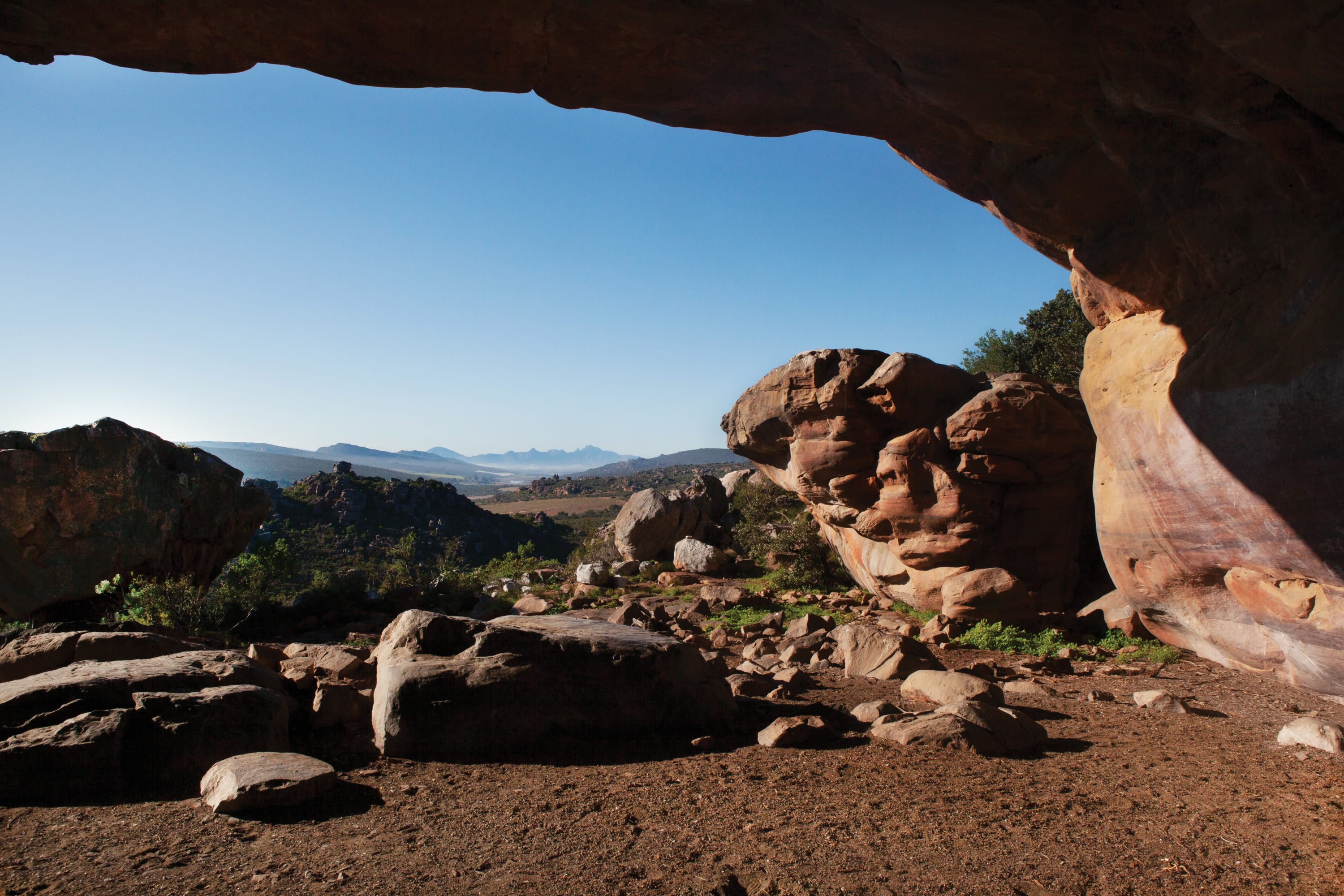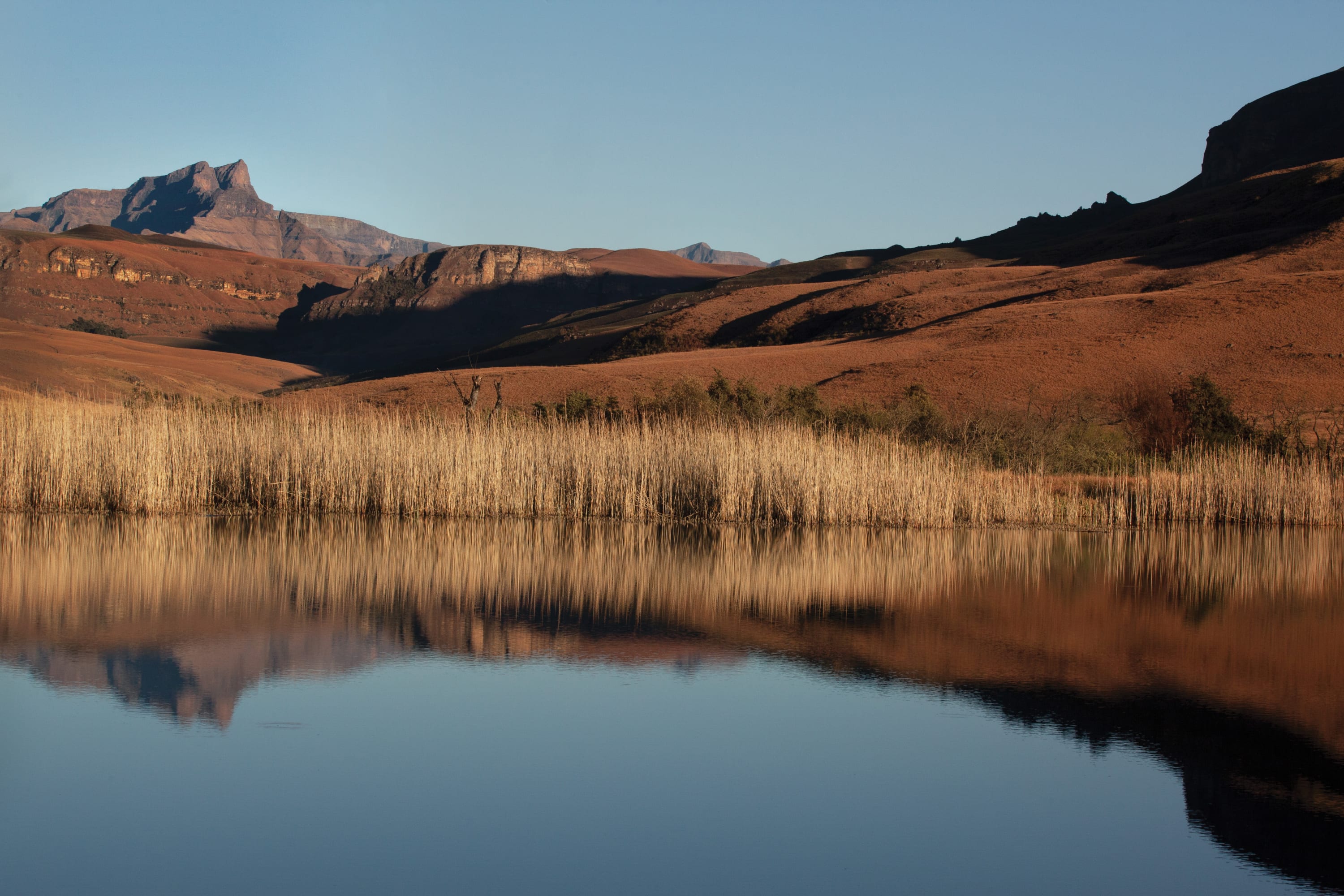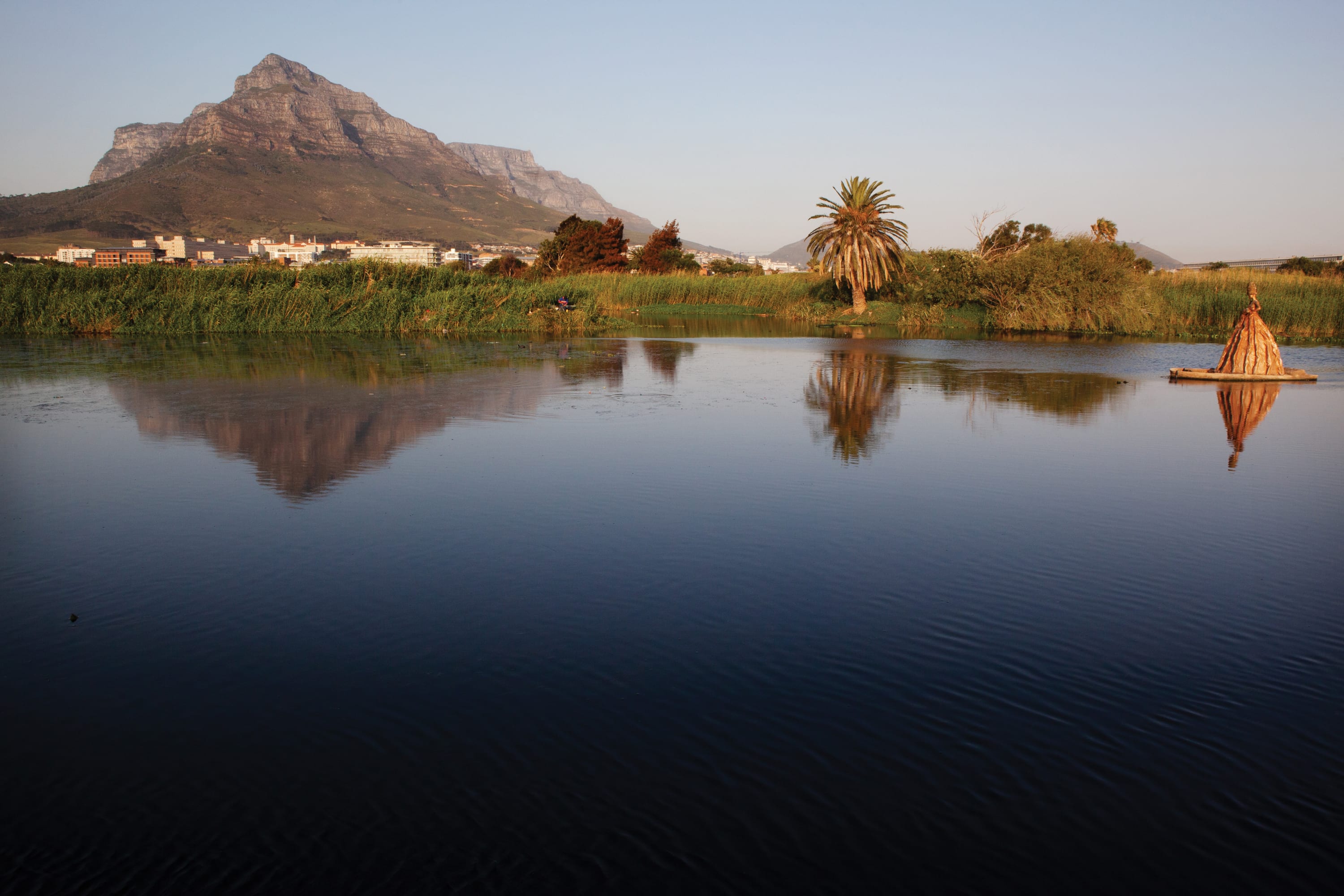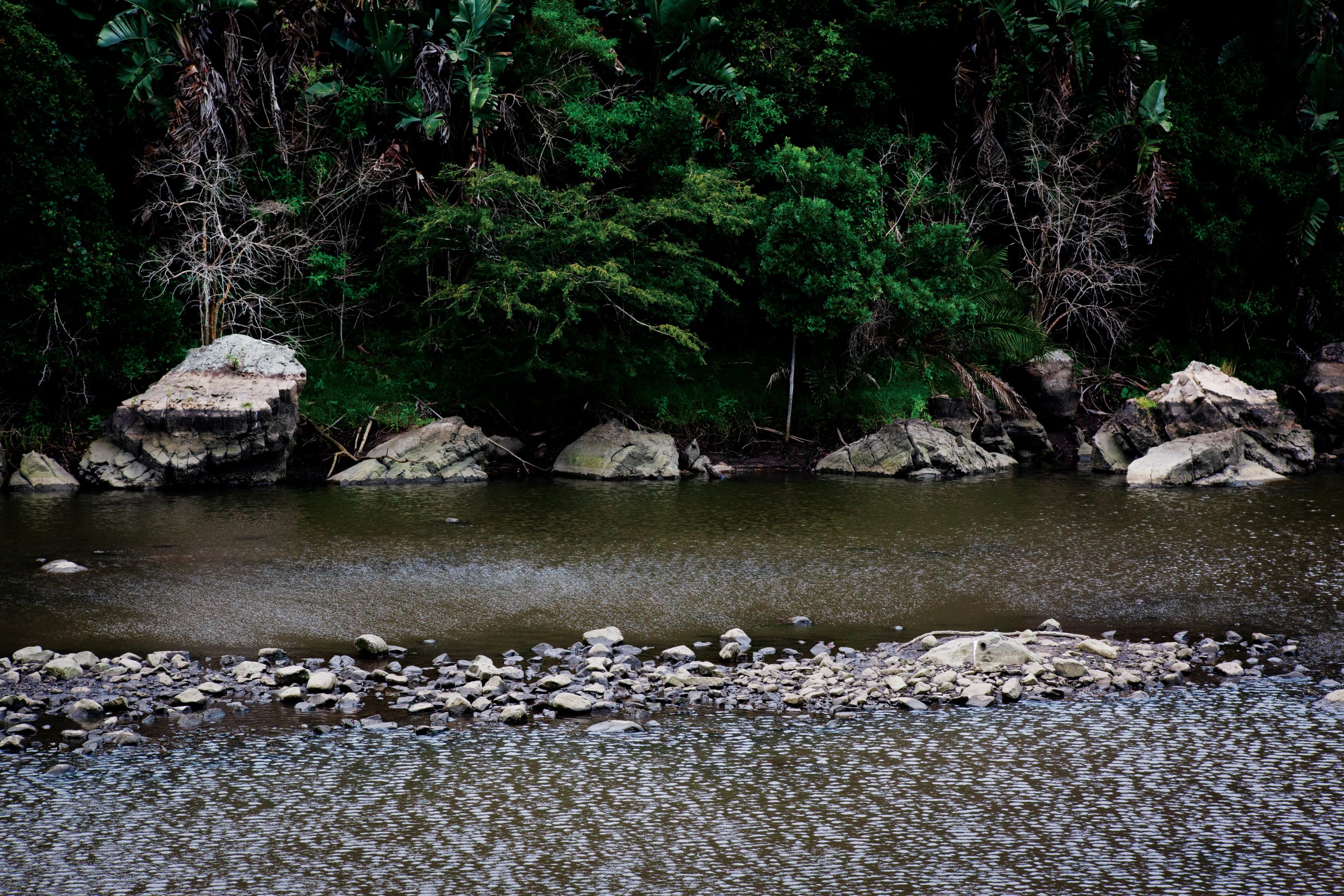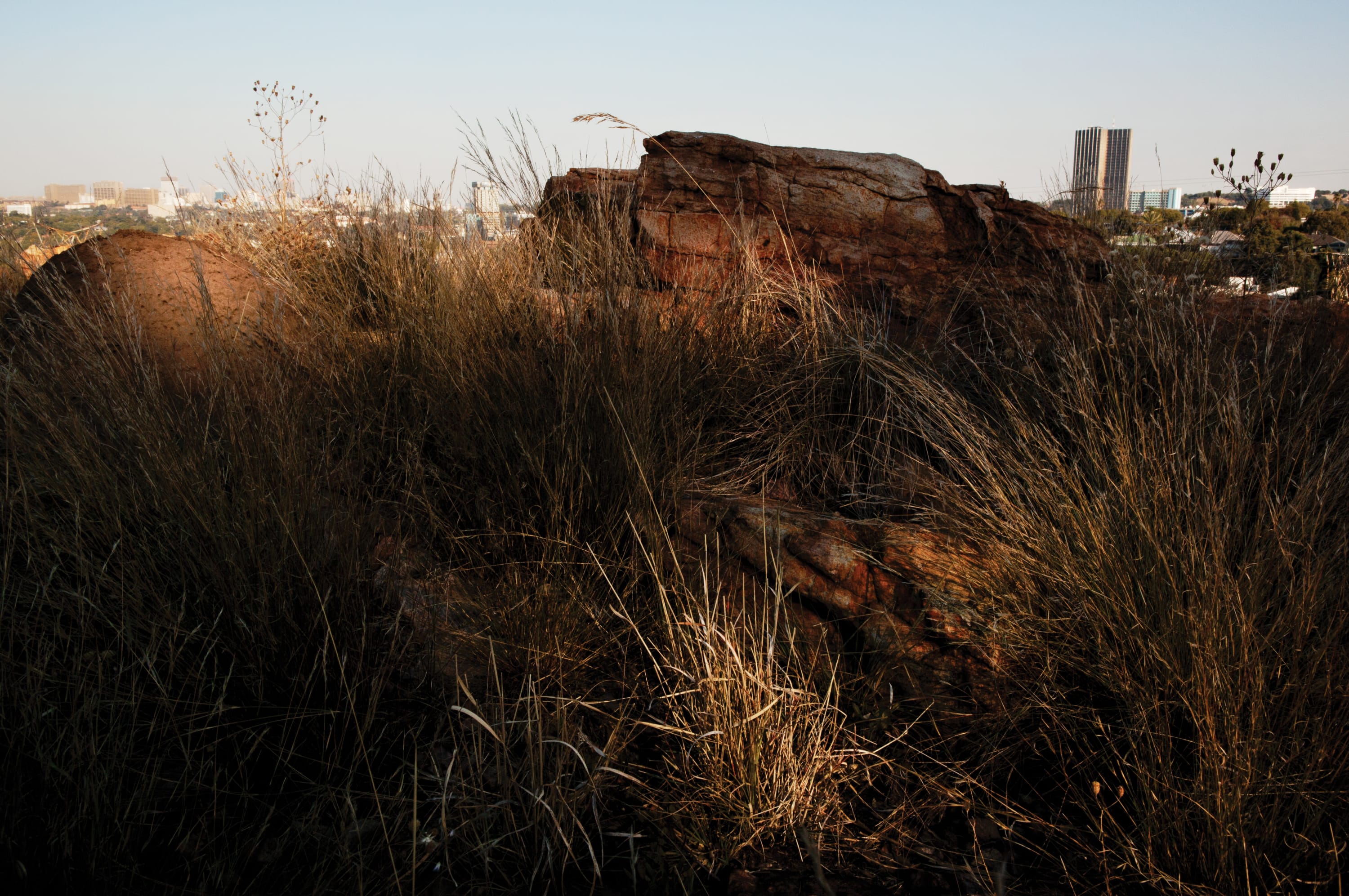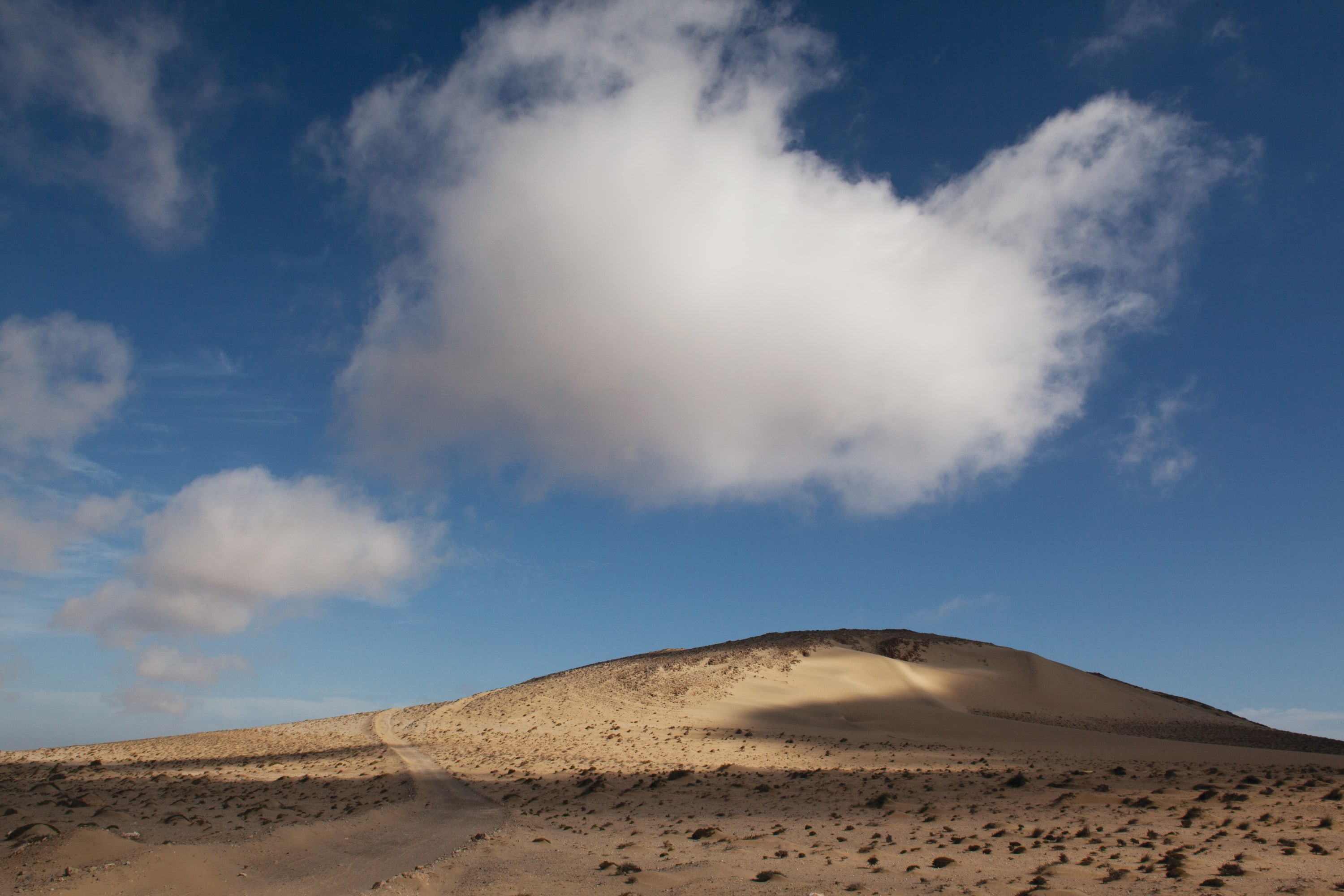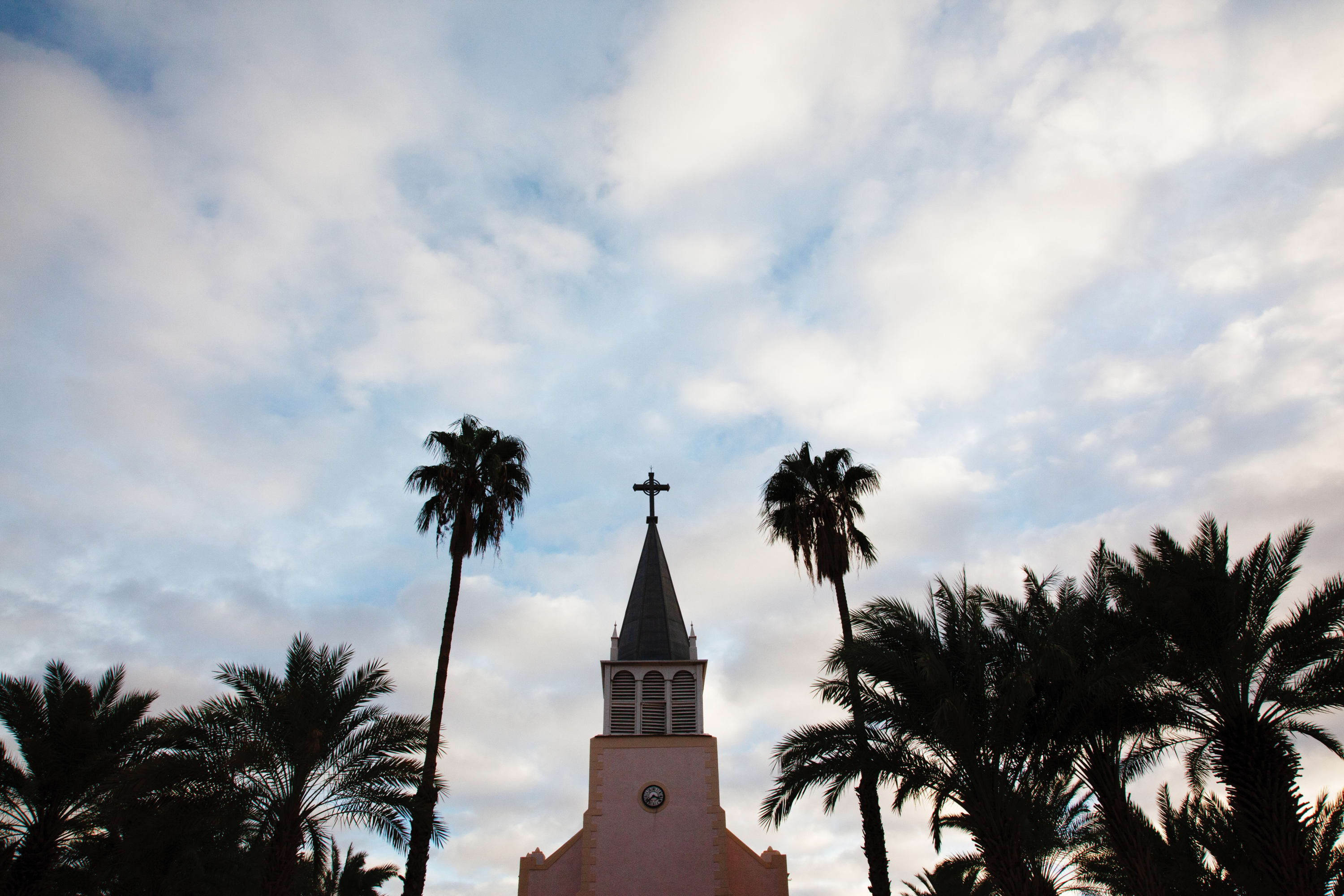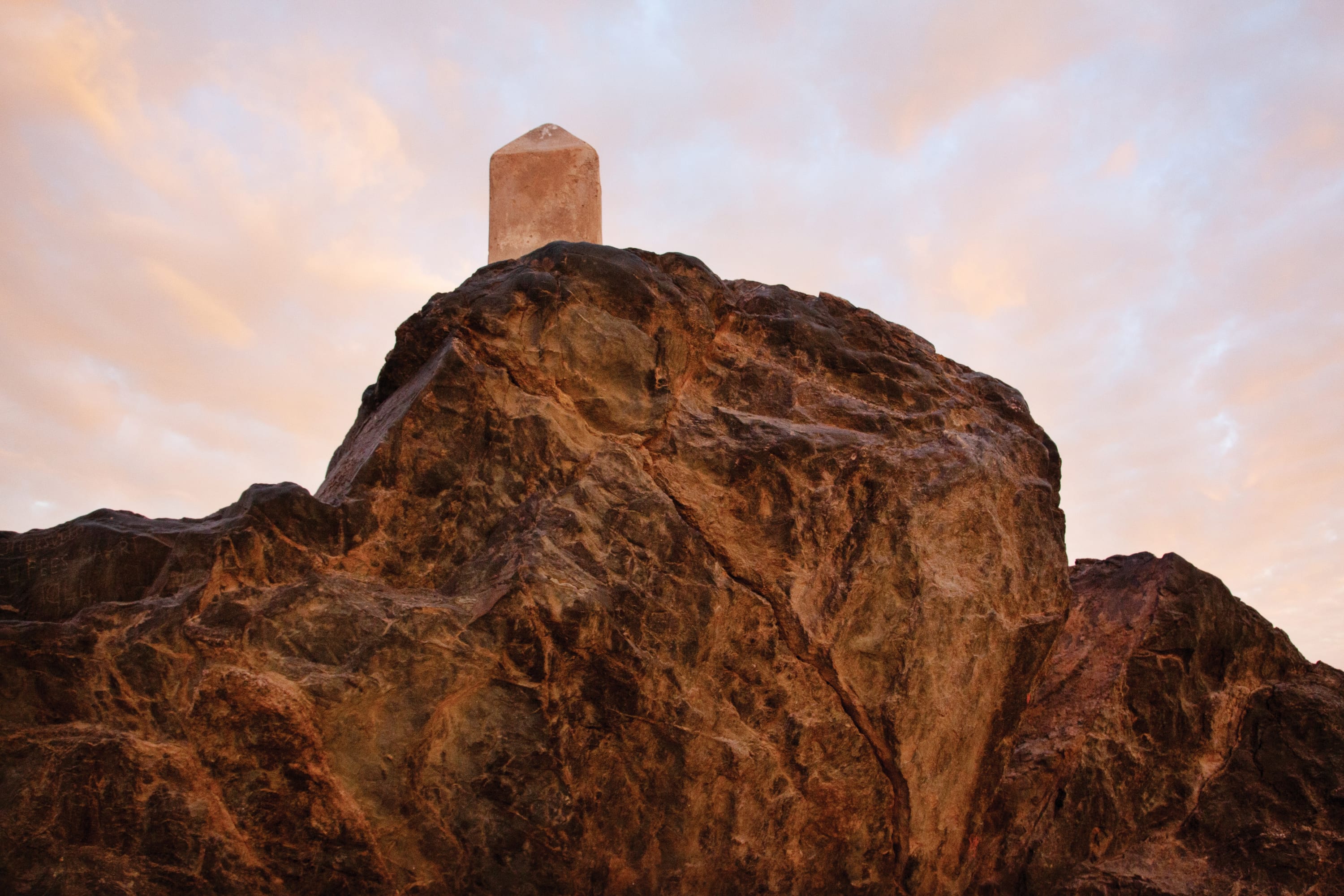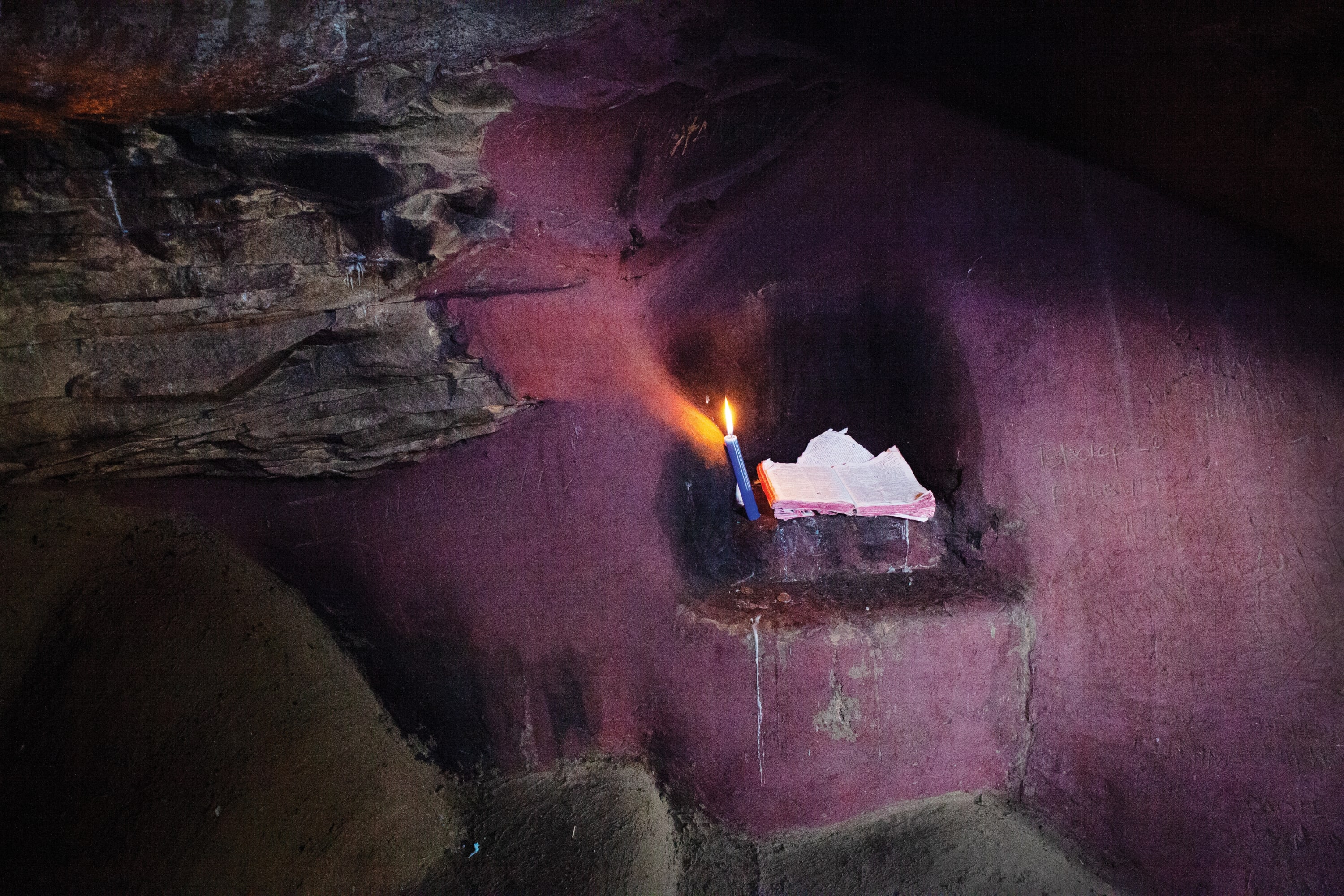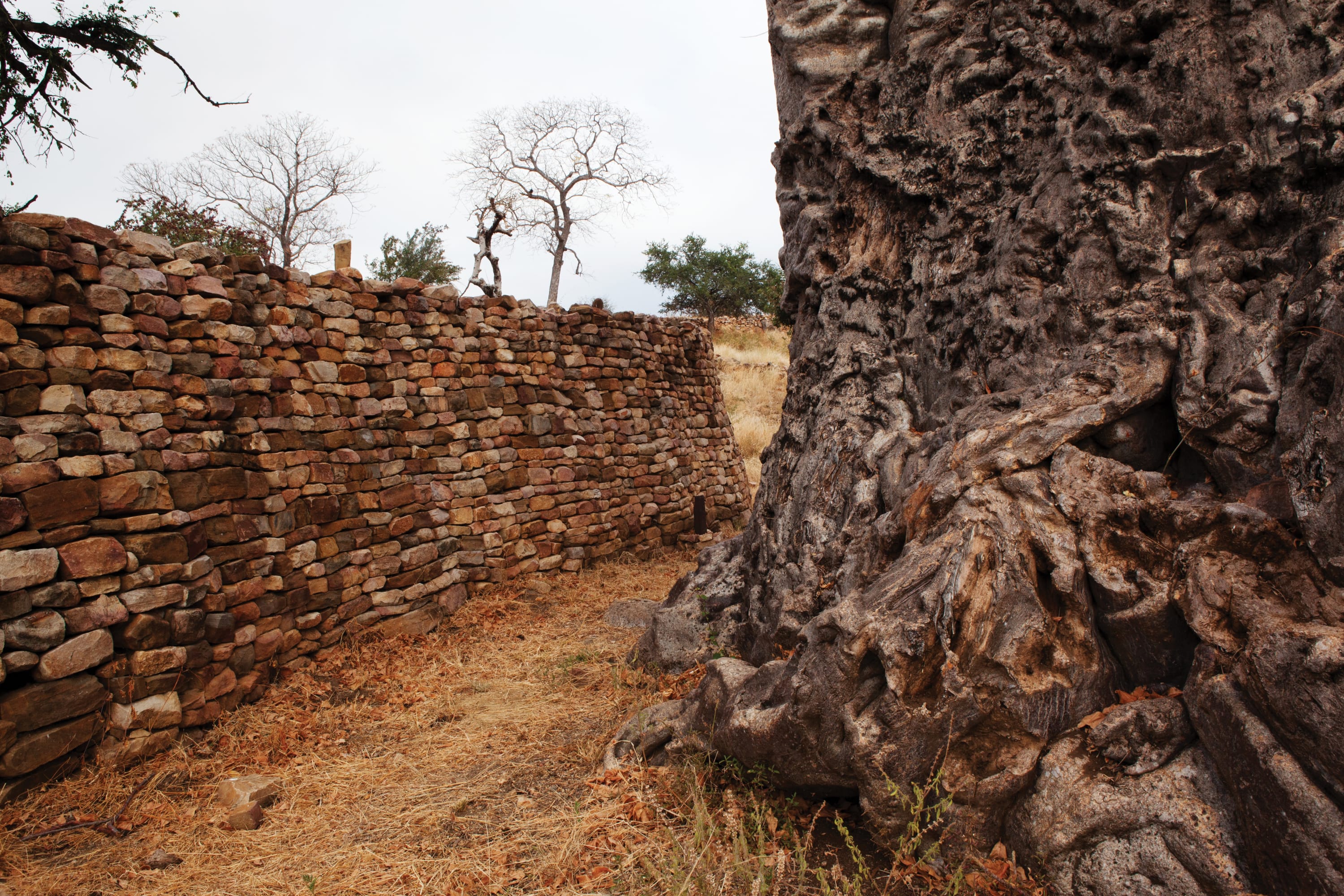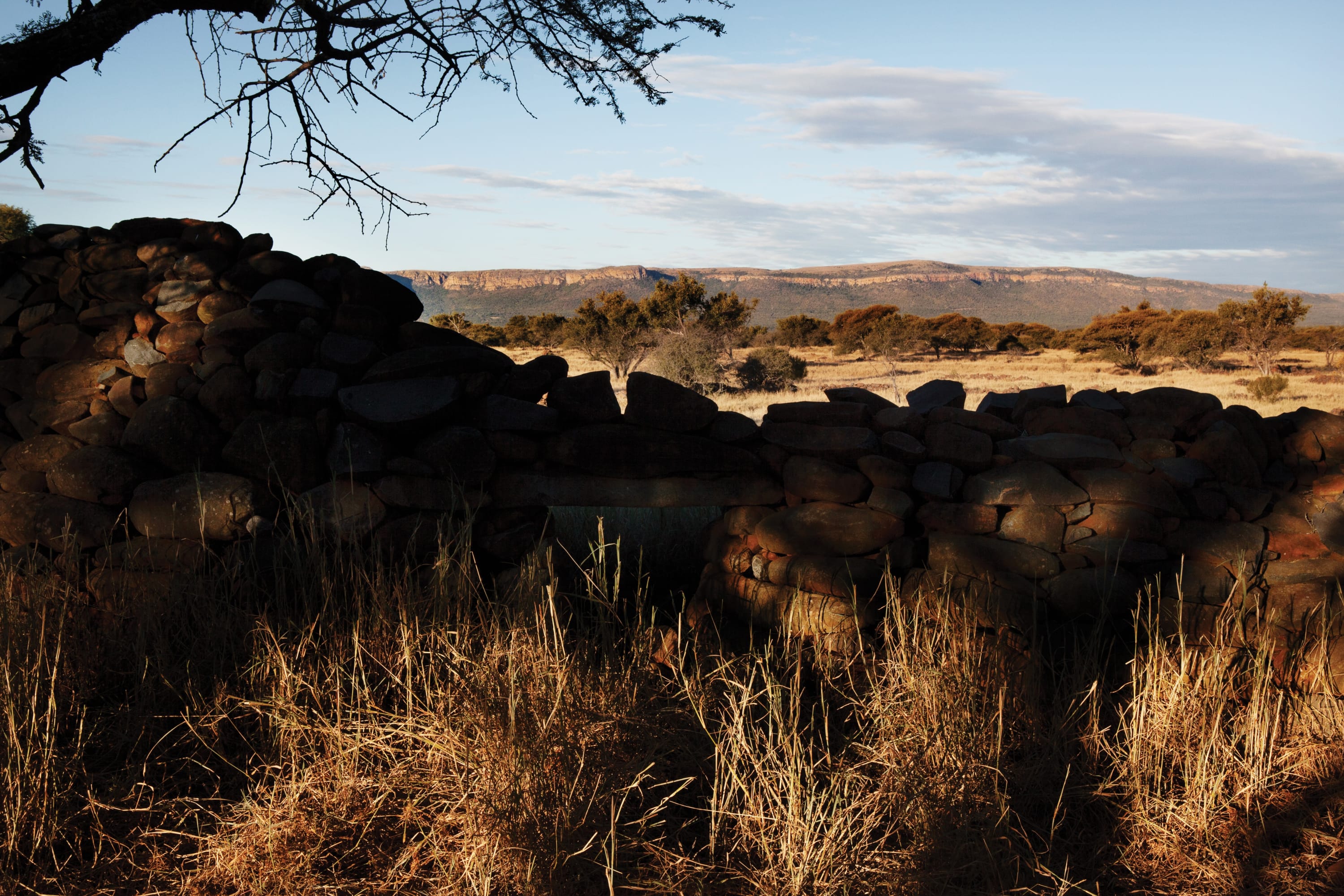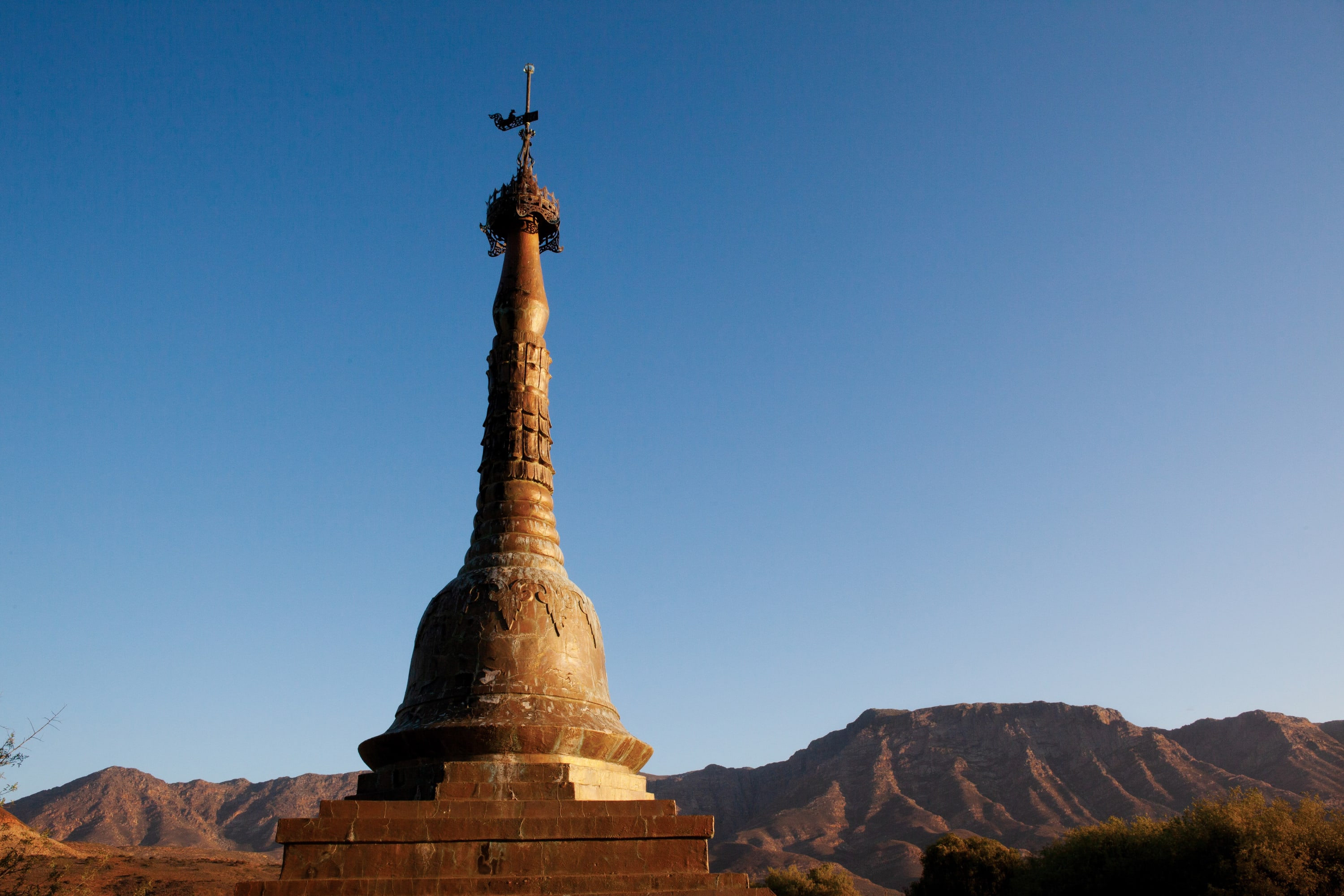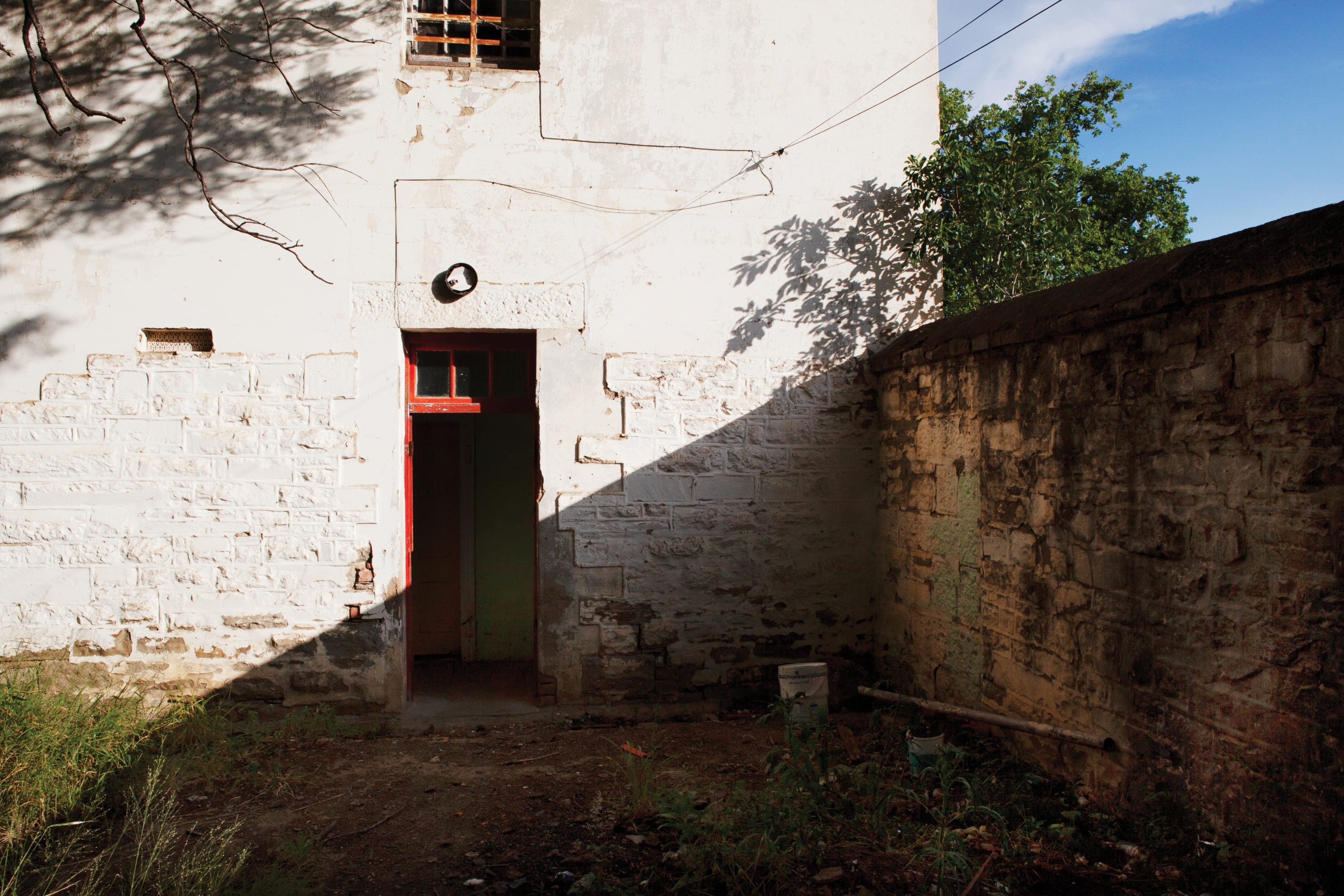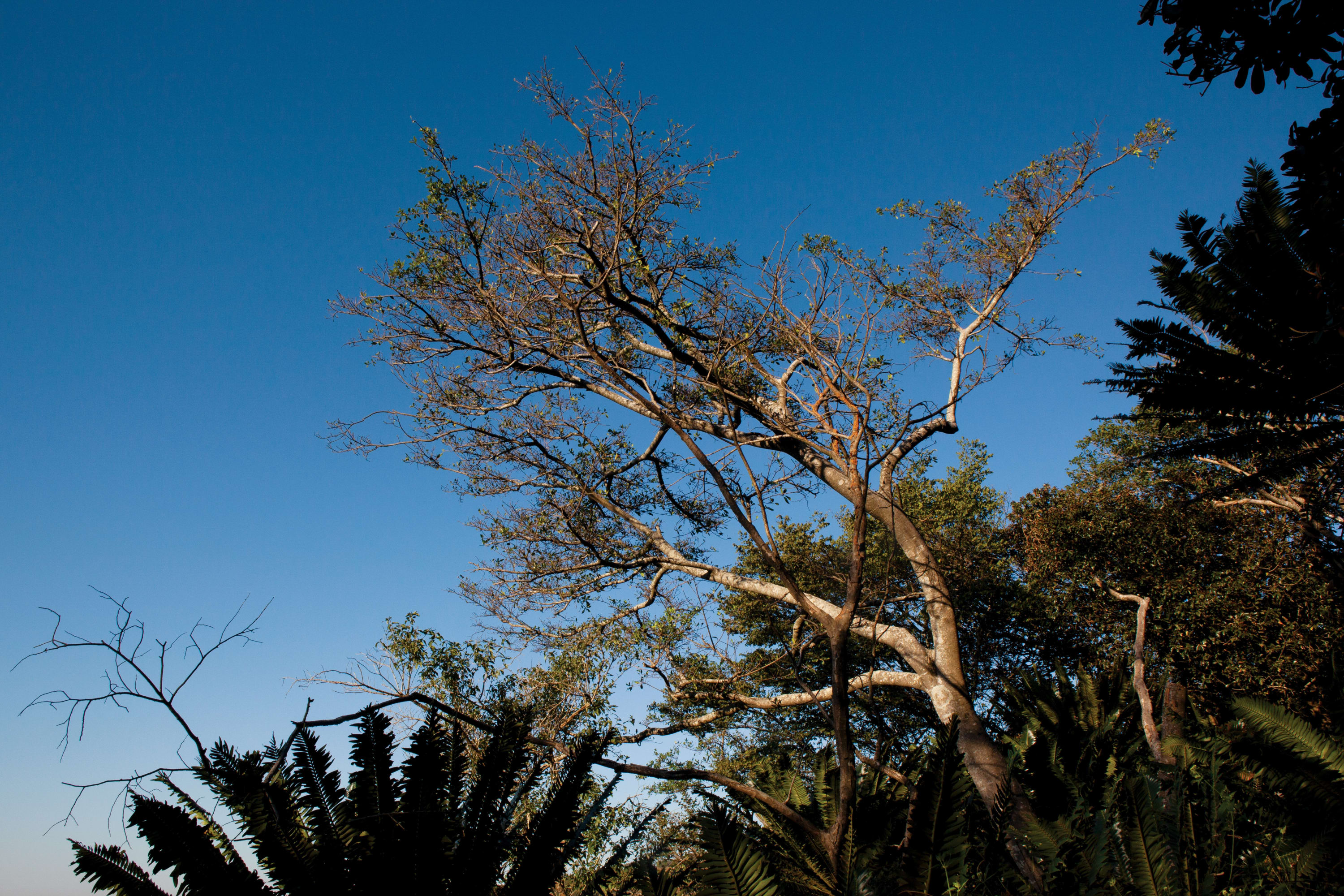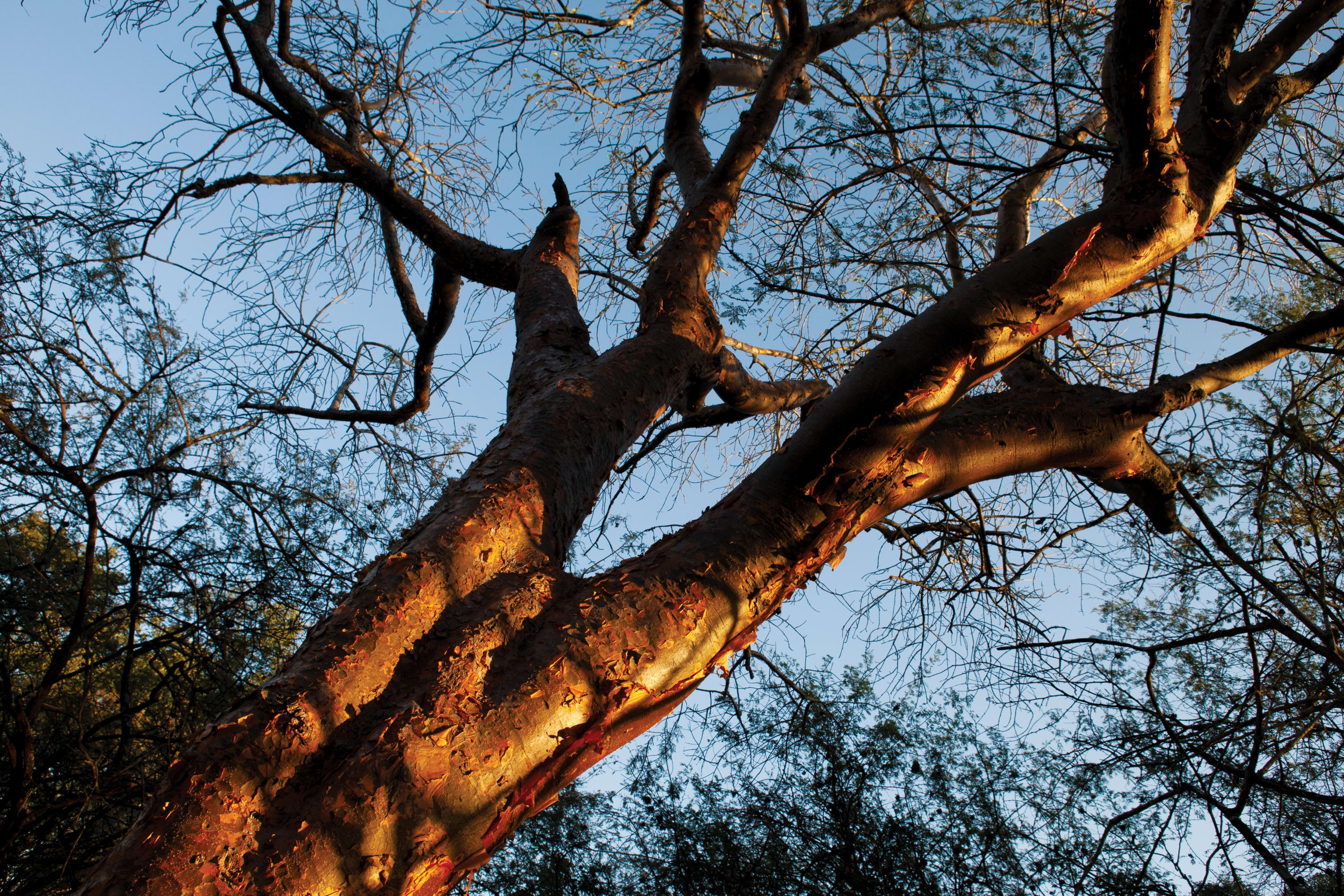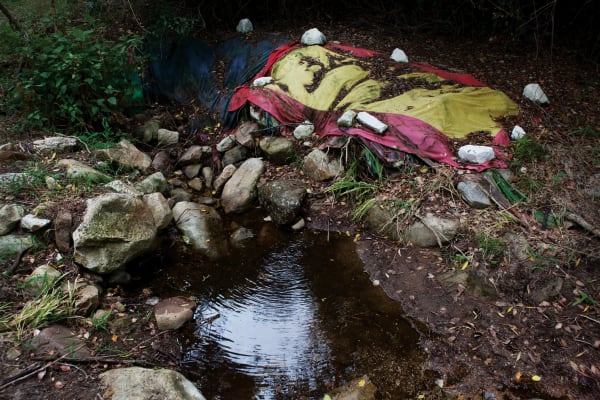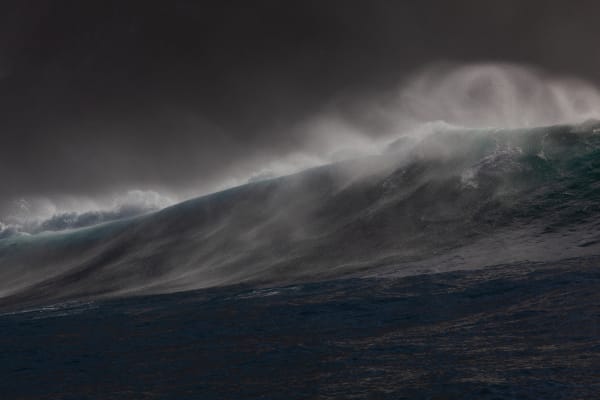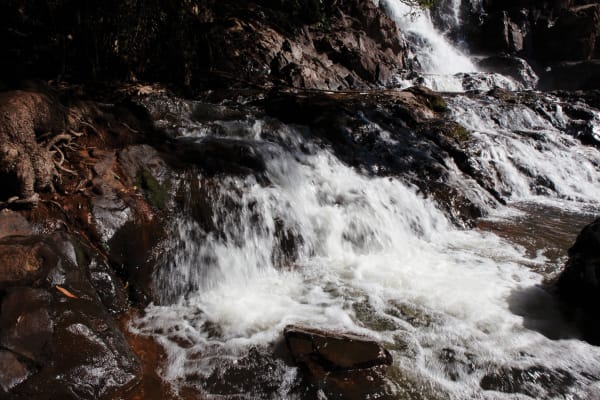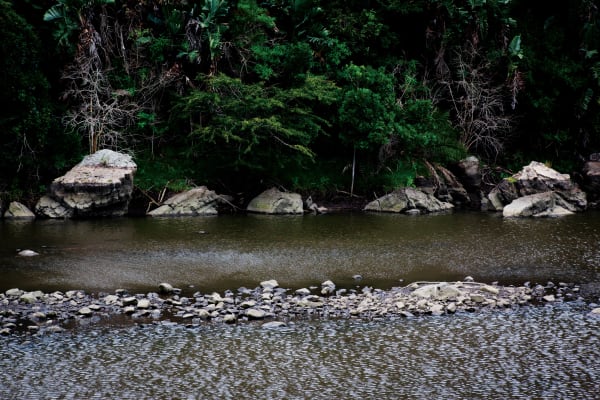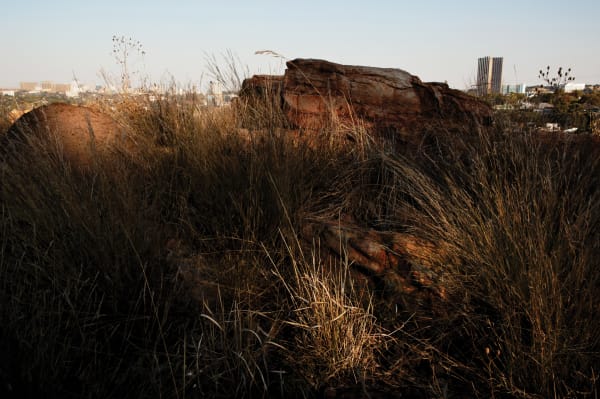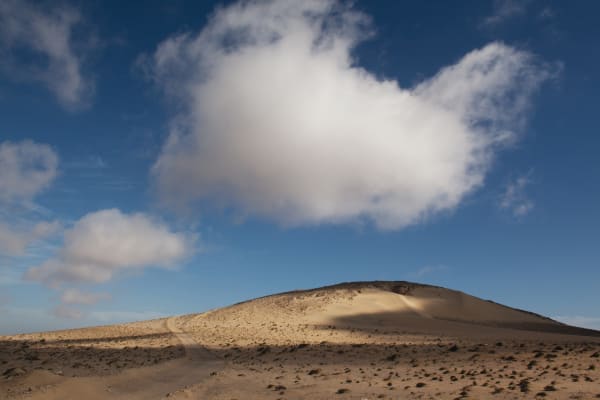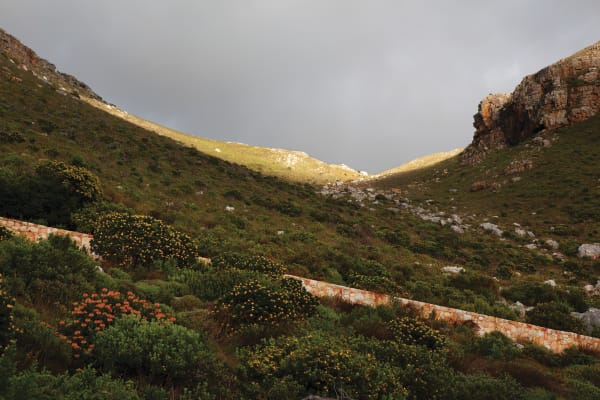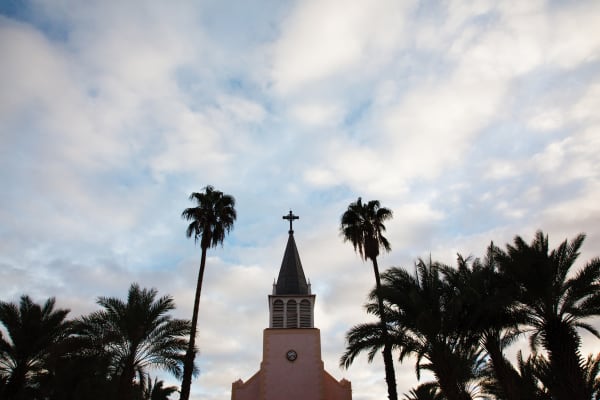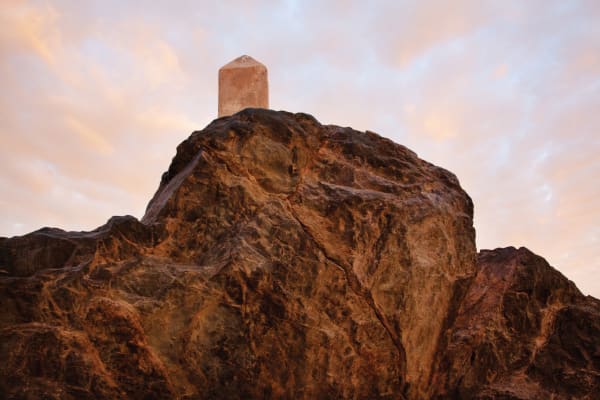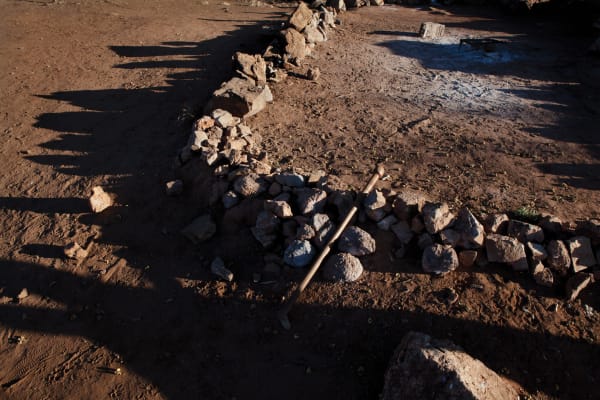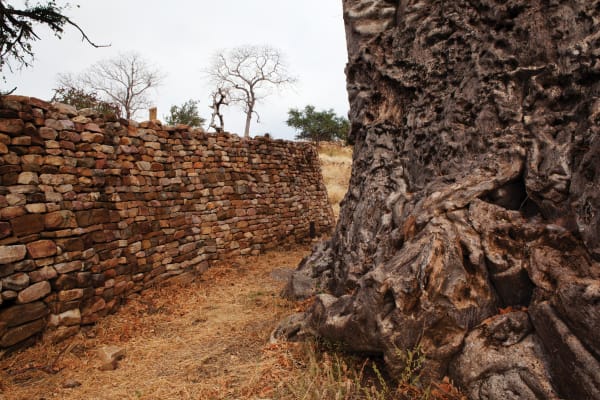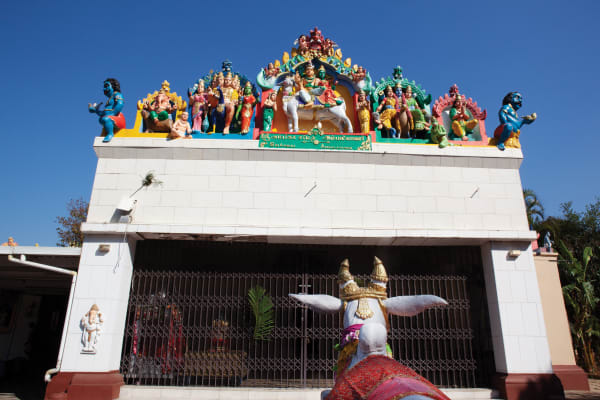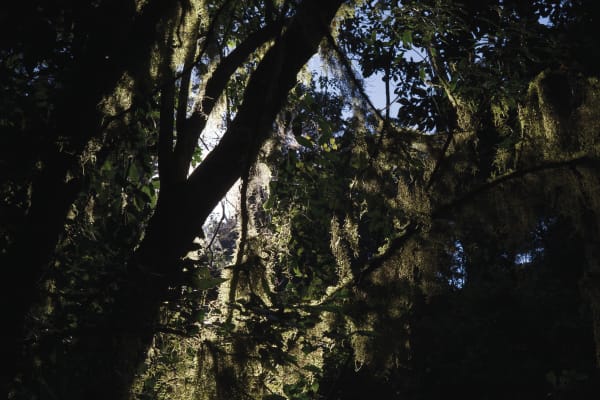Paul Weinberg: Earth Songs
-
"Life is the binding and connecting way....if you are alive, you are connected to everything that one has around us and that oneness is the land...the land owns us."
– Bob Randall, Aboriginal elder -
Artist’s Statement
“Our belief is that land is a gift from God and from our ancestors who have not left us. We continue to see ourselves as stewards of God’s resources, especially of communally owned land.”
Z. Nkosi, Spirituality, Land and Land reform in South Africa
Earth Songs explores and celebrates spiritual connections to the land in South Africa. While the ownership of “land” in this country is a highly contested issue, people have long marked and celebrated their spiritual connections to the land in ways that signify and re-imagine what it means for a variety of its inhabitants. Such meaning-making often etches the landscape, turning it into a natural canvass through which layered stories, manifest or buried, are expressed.
In quiet ways beyond the news and headlines, people of all traditions, persuasions, faiths and spiritual engagements partake in formal and informal rituals that mark the land in ways that align with their beliefs. They may go on pilgrimages, or re-ritualise places of archaeological, historical and cultural significance. Such rituals may take place in makeshift places of worship, in caves, next to rivers, or in churches, temples and mosques. In some instances, these spiritual sites are well-known, like Mount Nhlangakazi, the endpoint of a 50 km pilgrimage for thousands of followers of the Ibanda lamaNazaretha (Shembe Church). In others, as in the case of Twee Rivieren, where a small statue at the confluence of the Swart and Liesbeek rivers in Cape Town pays homage to the brave Goringhaiqua Khoi who defeated the first colonisers in 1510, these sites are less known. The lesser-known sites often tell stories of contest and simultaneous spiritual significance that need to be told more volubly and heard more widely.
This project explores many of these lesser-known, lesser-recognised, off-the-beaten-track, unusual sites of spiritual practice and ritual, bringing to the surface histories that are often muted or erased. Collectively, this work is an amalgam of spiritual connections to our land that celebrates our diversity, engages with our past and, for many, transcends the everyday. This project complements and expands on the extensive book I did on rituals and spiritual practice called Moving Spirit (1996–2006). It hopefully offers another way of understanding our country and reflects the essence of spirituality that lies deeply embedded in our land.
Paul Weinberg
-
Foreword
Land remains one of the most political and contested elements of South Africa’s past and present. From the first encounters between indigenous inhabitants to later colonialists, segregationists and the more recent democrats, land has been used to divide the country and
her people.
But it has also drawn her people closer to her, enfolding them in a very sacred embrace. In this pristine collection of visuals, Paul Weinberg takes us to this side of the continuum, elevating the meaning of land to this higher, more spiritual plane.
Weinberg has traversed the breadth of the South African landscape to portray its deep and intrinsic meaning and encapsulate the inter-connections of cultures and peoples across the spectrum of time. He traces these intersections from the first peoples, the San and Khoi, whose domain this land was for centuries, to those who came from elsewhere on the continent and from across the seas. His moving imagery harnesses the spiritual rituals of a cross-section of southern Africa’s belief systems – indigenous, Muslim, Jewish, Zionist, Roman Catholic, Buddhist and more. As you page through these visuals, you will have the unique opportunity to gaze differently, and with deference, at the world we inhabit.
In a sense, Earth Songs eloquently draws together the ethereal or intangible realm of belief and ritual with the very tangible soil that makes up our landscape. As the title indicates, it chants the songs of the people who inhabit this southern stretch of African earth.
Karen Leigh Harris, PhD
Department of Historical and Heritage Studies University of Pretoria -

The San signified their spiritual connections to the land through rock engravings and paintings. One San group, the /Xam people, would invoke rain through a ritual rain-maker who would lead a water-bull to a site where they wanted rain to fall. The bull would be sacrificed, with the flow of blood signifying the flow of rain. Archaeologist Jeanette Deacon’s research has connected physical engravings with 19th-century testimonies of /Xam informants who shared their stories with Bleek and Lloyd. She notes, “the cosmos that linked the ground and waterhole with the spiritual realm in the sky is referred to in the rock engravings through metaphors and activities of the !gi:ten (rain-maker) as they communicated with the spirit world.”
-

Diepkloof cave is one of the earliest sites where art engravings on ostrich shells were discovered, dating back 60 000 years. Archaeologists found 270 fragments with geometric symbolic patterns in the cave. They claimed that these artefacts form “a system of symbolic representation in which collective identities and individual expressions are clearly communicated, suggesting social, cultural, and cognitive underpinnings that overlap with those of modern people.”3 Indeed, Shigeru Miyagawa of Massachusetts Institute of Technology (MIT) suggests that “art is not just something that is marginal to our culture, but central to the formation of our cognitive abilities.”4 The caves also have representations of later San and Khoi rock art.
-

There are over 50 000 rock paintings in the Drakensberg area that span millennia of the San hunter-gatherers’ existence in southern Africa. While it was thought that the Abathwa, the last living San of the Drakensberg, had been wiped out during the 19th century, a group of San survivors continued to practise their beliefs and traditions in secret. After South Africa’s democratic transition in 1994, the Duma clan, once considered one of the original Zulu clans, claimed their San heritage and regularly return to this part of the Drakensberg to perform sacred rituals among sites with rock art. Scholars like David Lewis-Williams and others have argued that rock art is connected to the San people’s cosmology. They argue that San spiritual leaders who were connected to the spirit realm through trance would translate these experiences by painting them onto the surfaces of rock shelters.
-

The city of Cape Town has a unique underground system of rivers that flow from Table Mountain and the surrounding highlands through the city. It also has an integrated seasonal wetland system. Perhaps not surprisingly, the original inhabitants of Cape Town called it Camissa, a Khoi name meaning sweet waters. Various San and Khoi groups lived harmoniously within this ecosystem in which they grazed their livestock, hunted the many species of wildlife and harvested bushfood. Like other indigenous groups, the linkage between the natural environment and the spirit world was axiomatic. When the first settlers arrived, they were astounded by this paradise and the abundance of wildlife.
-

The Dutch East India Company (VOC) brought practising Muslim slaves (including a number of high-ranking imams) from Indonesia, Malaysia and other colonies to the Cape. Many were relocated to the Cape for resisting colonial invasion in their own countries. With them, they brought Sufism, a mystical expression of the Islamic faith in which devotees enter a trance state to personally experience God. Still widely practised in the region, Sufism had a profound influence on indigenous people and emerging spiritual practices. The work of these early devotees can still be read in the landscape, and particularly in the number of kramats throughout Cape Town. A kramat is a spiritual site where Muslim saints and Auliyah (friends of Allah) are buried. There are at least 31 kramat sites in Cape Town, of which the most prominent ten form the so-called “circle of tombs” that encompass the slopes and top of Signal Hill, sites in Oude Kraal and Constantia, Zandvliet farm and Robben Island.
-

Tashlikh, the emptying-your-pocket or casting-off-your-sins ritual performed by orthodox Jews during Rosh Hashannah (New Year), has been practised since the 13th century. The ritual symbolises ablution and a return to a purer self. Water, central to the creation of life, is also associated with the cleansing of the body and spirit. This ritual is practised throughout the world by people of the Jewish faith on this holy day. By 1914, 40 000 Jews had settled in South Africa, peaking at 120 000 in 1970. Today, the Jewish community numbers around 80 000 people, including the Lemba, whose DNA has been proved to link to the 12 tribes of Israel.
-

Twee Rivieren (literally “two rivers”, referring to the Liesbeek and Swart rivers) is at once a site of conflict and one of spirituality. Widely acknowledged as the site of the first conflict between European settlers and indigenous Khoi people in South Africa, the actual site of the battle is unknown. However, “the historicity of this site draws significance from the precolonial inhabitation by the Khoi, the hippo, the lion and wildlife that were wiped out by the intrusion of the Dutch East India Company (VOC). It is an area of contact with the Portuguese in 1510 when a great battle was fought between Viceroy Francisco D’Almeida, the first governor and viceroy of the first Portuguese State of India, and the Goringhaiqua. On 1 March, he was defeated in battle by the Khoi.”5 Twee Rivieren is also the site of a present-day contested development project.
-

In South Africa, as in some other parts of the world, there is a strong connection between big wave surfing and spirituality. Dungeons, near Hout Bay, is one of the top big wave surfing spots in the world. People refer to the connection between surfing and spirituality as a release, a meditation, and a oneness with nature. Soul surfer Keith Glendon describes this connection as follows: “The sea holds a magic for those of us who know her. A magic so simple, pure and powerful it works as an unseen force in our souls. We’re drawn to her. The spirit of the sea moves in us as we move within her, undulating folds in pursuit of our peace. As surfers, we inherently know this to be so. The sea brings comfort, solace, release and escape. The sea brings healing. The spirit of the sea, for some of us, is the very essence of life.
-

Phiphidi Falls is a sacred site of the Ramunangi clan of the Vha-Venda. Traditional beliefs hold that ancestral water spirits reside in the pool and waterfall. To appease these spirits, descendants regularly need to pour libations of grain and beer at the site, while local clan members regularly pray there for rain, health, good harvests and peace. An interlayered set of beliefs, laws and rituals determine cultural and spiritual practice at Phiphidi. In 2010, the traditional custodians of the site warned of its “defilement” at the hands of careless tourists and property developers, but today it is successfully managed by conservation authorities and local authorities.
-

In the mid-19th century, the Xhosa prophetess Nongqawuse received revelations from her ancestors at the Gxarha river mouth valley that would have a profound impact on her people. Her prophecies arose in a context where the colonial government persistently intruded on Xhosa territories and where locals responsively resisted such aggression. At the time of her visions, the region experienced a severe drought and bovine lungsickness. Nongqawuse prohesised that the mass slaughter of their cattle would see the Xhosa ancestors rise from the dead, defeat the colonists, and return the Xhosa nation to its former glory. Her prophesies started a millennial movement that threw the Xhosa nation into a tragic spiral that hastened the colonisation of the area.
-

Every year, the followers of the Ibanda lamaNazaretha (Shembe Church) embark on a pilgrimage from Inanda to Mount Nhlangakazi, 50 kms away. Church followers believe that it was on this holy mountain that the church founder, Isaiah Shembe, received the revelations that constitute the bedrock of their faith. Here, they pray several times a day and dance a slow Zulu rhythmic beat accompanied with drums and at one time, horns, but by trumpets today (not unlike a vuvuzela). It is a performance which one devotee described as, “dancing for God.”
-

On the morning of 24 May 1921, a force consisting of 800 white policemen and soldiers confronted an African prophet, Enoch Mgijima, and some 3 000 of his followers at their holy village of Nthabelanga in the Eastern Cape. Called the Israelites, Mgijima’s followers had been gathering at the holy site since early 1919 to await the end of the world. They refused all attempts by the authorities to remove them from the site. With rifles, machine guns, and cannons, the government forces killed nearly 200 Israelites who challenged them with knobkerries, swords, and spears. This massacre has been likened to Sharpeville and Marikana, but while political convictions animated the resistance in 1960 and 2012, the so- called Bulhoek massacre saw state forces arraigned against the visions of a prophet and the religious beliefs of his followers.
-

Layers of history are buried in the Melville Koppies landscape on one of the few remaining archaeological sites in Johannesburg. Archaeologist Revil Mason found early hominid sites dating back some 250 000 years, a San settlement in a cave dating back 100 000 years and more recent Iron Age Tswana settlements from about 500 years ago. Mason was able to show a grouping of people who practised pastoralism, agriculture, metal craft and were involved in trade. The Tswana people lived in this area until about 1820 when they fled from Mzilikazi who in turn was on the run from Shaka. The discovery of gold and the subsequent development of mines in the late 19th century led to the destruction of much of this region’s rich social history. Today, a variety of Zion Church groups and izangoma (spiritual practitioners) regularly visit this space, adding further layers of cultural life and history.
-

Boegoeberg is a revered site for the once-nomadic Nama people. Historically, Nama communities stayed here as they travelled south for summer and north for winter grazing. Boegoeberg is situated between Alexander Bay and Port Nolloth on the West Coast. Today, it is within the Alexkor mining area and is inaccessible to the public. When Boegoeberg was excavated for diamonds, the miners found Nama graves and middens created by Nama ancestors. Archaeologists who studied the graves found rich information about Nama burial rituals and deep insights into the lives of the once-nomadic Nama. There are moves afoot by government and planners to turn Boegoebaai into a deep-water port.
-

There are about 3 million foreign Africans living in South Africa, among which is a group of about 30 000 Nigerians. On Signal Hill in Cape Town, a group of Nigerians meet daily to pray and practise their faith. These are not members of the well-known and often large “prophet healing” Pentecostal churches for which Nigeria is famous and that South Africans often see on televangelism shows. Using a small pile of rocks as a pulpit and seating themselves in a clearing around it, these practitioners spend many hours quietly singing and praying in their native languages. Xenophobia, marginalisation and the need for self-identity all contribute to the proliferation of small church groups such as these.
-

A non-stop church meets every day on Pecks Peak behind Muizenberg in Cape Town. The group is mainly from Burundi but also offers a haven for many other foreign Africans who come from townships on the Cape Flats to attend these ceremonies. Like the small Nigerian church gathering on Signal Hill, this small outdoor church attracts a steady flow of followers. I met Zimbabweans, Rwandans, Malawians and people from the DRC on the way up the mountain. The preacher told me his story, which could probably be repeated by all on the mountain trail. “It was very difficult to get here. I left my country because of unstable politics. I do piecework to support my wife and two children. Even though I’ve been here for 14 years, I still struggle to get formal work because I am not registered as I don’t have citizenship.” The view from the church site stretches from the Indian Ocean to Cape Town’s Flats and endlessly north, to those places from which the congregants have come. Two days before my visit, there were attacks against foreigners in the country. Lost in prayer and speaking in French, snuggled in the fold of the mountain, this small group were safe amongst each other in their temporary sanctuary.
-

Ratelgat is the spiritual home of the Griqua, a group of Khoi people, who have lived in various parts of South Africa for over 200 years. Founded by Paramount Chief Andrew le Fleur, Ratelgat is now a heritage site. As Yvette le Fleur, the representative of the Griqua National Conference expressed it, “For us the acquisition of this piece of land is not only an inheritance in the land itself but even more significant to the Griqua, is the inheritance of the spirit of our ancestors; who could survive through very difficult circumstances the onslaught of colonialism on this very arid piece of land in the heart of the succulent Karoo.”
-

The Roman Catholic church in Pella, in the Northern Cape, was a sanctuary for refugees in the 18th and 19th centuries. Established by the London Missionary Society, the first church on the site was attacked by a group of marauding San in 1815 and lay abandoned for much of the 19th century. In the 1880s, Father Simon and Brother Wolf re-established a Catholic church and community on the site, both of which survive to the present day. Throughout this recent history, it has been a hallowed site for various indigenous communities engulfed in ongoing struggles with each other and colonists.
-

The Nama of the Northern Cape used to be a nomadic people, but a range of factors from the mid-19th century onwards led to radical socio-economic changes, the slow erasure of their traditional lifestyle and the loss of their language. In increasing numbers, mining prospectors, white farmers and missionaries encroached on their land and parcelled it off while mission education discouraged the use of Nama. Settled, many Nama became farmworkers and labourers. When the Catholic mission was established in the late 19th century, the resident priest made regular visits to the farmers who lived on the outlying livestock posts and held services in the Mik, a cave church. Attendance at the Mik was largely by the Nama community, who continued to worship there and welcomed other denominational services. The community saw the influence of the various church denominations as a means to share, commune and engage with outsiders.
-

The Nama community’s deep roots in the Richtersveld landscape created a repository of intangible knowledge which continues to serve as spiritual inspiration in their struggles against outsiders. While the Richtersveld has been declared a heritage site, the proliferation of mines and low-key tourism compete with indigenous Nama farmers’ grazing space and rights. Growing volumes of mine waste also inevitably leach into the landscape and corrode its physical beauty. In the face of these pressures and the scars on the Richtersveld, Bidklip is an indigenous symbol of meditation, remembrance and spirituality.
-

Izangoma (healers), izinyanga (herbalists) and followers of various Zion-based churches often frequent the Motouleng caves near Clarens for spiritual fulfilment. Formal and informal pilgrimages are common occurrences. Motouleng is especially regarded as a site where women who struggle with fertility issues can find succour. In African ancestral veneration, geographical places have long been viewed as both physical and spiritual spaces, with certain caves in particular serving as conduits of the “living dead” (Bodimo, ancestors) and the means through which ancestors reveal a path to a greater divine power (Modimo in SeSotho).
-

The Mantsopa Cave Church of Lekhalong la bo Tau region (the Pass of Lions) has had many iterations. In the mid-19th century, Canon Henry Beckett, the Superior of St Augustine, established a mission here, but with time, the cave became a meeting point of many different spiritual practices. As anthropologist David Coplan noted, “Pilgrims to the sacred caves practise every form of African religion from pre-Christian Basotho ritual and medicine to independent Apostolic to established mission church Christianity.”8 It is also where prophetess Makhetha Mantsopa, niece of King Moshoeshoe, is buried. She predicted the Mfecane, which caused widespread chaos, disruption and warfare among indigenous communities in the 19th century, and the short but decisive battle with the British called “the hail of bullets”. She fell out of favour with the king’s son, Letsie, who drove her over the Orange River border into exile, where she lived for the rest of her life. Later in her life, Mantsopa converted to Christianity.
-

Madimatle, meaning “beautiful blood”, is a holy mountain and cave that has been a site of spiritual practice for Setswana communities in South Africa and Botswana for centuries. Its revered oral history dates back hundreds of years. People from these communities regularly visit the site for spiritual ceremonies, healing and initiation rituals even though they were removed from the land in the 1930s. Today, Madimatle is subject to a land claim by the Manaiwa family and community who once lived there. In recent years, there has also been a dispute over a mining claim on the land. The South African Heritage Resource Agency (SAHRA) has determined that it should be granted cultural heritage status.
-

Lake Fundudsi is a sacred site of the Vha-Venda people. It is believed that an albino python is its guardian. The lake is inextricably linked to the Domba (snake dance) performed by young Venda maidens who come to bathe in the lake as part of the Domba dance ritual and connect with Vha-Venda water spirits. The water from the lake is considered holy, and collecting firewood from the region is not allowed. It is believed that an unseen community lives under the lake because local people report hearing drumming at night. Legend has it that the lake once ran dry. In response, traditional healers advised that a young maiden needed to be sacrificed to restore the lake. After Nangomi, the chosen maiden, was sacrificed, locals testify that the lake never ran dry again.
-

Thulamela is a sacred site of the Vha-Venda people that is linked to Mapungubwe and the Great Zimbabwe complex of kingdoms. The historic and heritage value of Thulamela and its related spaces carries meaning into the present. It is hard to draw a line between tangible and intangible heritage here as belief systems of earlier periods speak in the present and through the lay of the land. Communities with historic linkages to these sites regularly visit to perform rituals here. As anthropologist Joost Fontein has noted, “Sacred spaces in the landscape act as ‘vehicles’ through which the social and sacred worlds meet. Not only are these liminal places on the landscape marked by specific customs, taboos and rules...it is through these practices themselves that their sacredness is achieved.”
-

At one time, Molokwane was a large settlement of the Sotho-Tswana people. The stone wall structures are reflective of early occupation and contemporary settlements. The patterns of macro (motse) and micro (kgoro) units represent one of the largest Iron Age Sotho-Tswana occupations from around the 14th century. While these early settlements provide evidence of vital and sustainable communities, the last two centuries saw the area suffer enormous hardship and trauma as a result of wars, colonisation, apartheid and the dispossession of indigenous land. Today, people of all faiths participate in healing practices at Thlolego Ecovillage and Learning Centre on a neighbouring farm, among the stone enclosures that were once part of the Molokwane settlement. Healing sessions focus on human restoration and the land.
-

The Peace Pagoda near Barrydale is believed to be the only such structure in Africa. Donated by Burmese monks shortly after South Africa’s new democracy, the pagoda is, according to Steven Aung, president of the International Buddhist Friends Association, “a key part of a series of pagodas constructed by caring and dedicated people around the world that all represent and pay tribute to a shared, universal mission of attaining peace.” Today, sadly, the pagoda is a contested spiritual site. The current landowners are Seventh Day Adventists and have denied access to visitors and practitioners of Buddhism because this clashes with their own beliefs.
-

The Shree Ambalavaanar Temple in Durban is considered a holy shrine for practising Hindus in South Africa. The first temple, built in 1875 at Bayhead, was washed away by floods. Another temple built in its place was forced to make way for a motorway. A number of the original deities housed in the original two temples have been relocated to the Shree Ambalavaanar site, which is now called the Second Temple. Annual firewalking ceremonies, draupadi, are held at the temple venue. It is a major attraction for Hindu and non-Hindu visitors. The resident guru believes that the South African version of Hinduism is very different from that practised in India. Because of colonisation, apartheid and oppression, he said, “our system is much more egalitarian — we cast away the caste system.”
-

eMakhosini, the valley of the Kings, is a site that embodies the connection between Zulu royal ancestors and their “Zulu spirit”. This is exemplified by the praise poem dedicated to King uSenzangakhona: “He plaited a long rope, son of Jama, he plaited it until it reached heaven.”10 It is at this site where Nkosinkulu, a forefather of the Zulu royal lineage, arrived in the late 17th century and where seven of the Zulu kings lived over a period of 200 years. In the 19th century, the valley saw much conflict — first among neighbouring clans during the Mfecane and then with the Boers and the British. At the time, Zulu kings like Shaka had their royal kraals here while other kings were buried in the valley. Nearby are the famous battles of Isandlwana, where the Zulu army defeated the British, and Ulundi, where the British finally defeated the Zulu nation.
-

On 7 March 1877, the first Zulu Christian martyr, Maqhamusela Khanyile, was killed for defying orders to serve in the Zulu military. He refused to join an ibuthu under King Cetswayo and was executed on Mpondweni Hill in Eshowe. In modern terms, he would be regarded as a conscientious objector. The Zulu military system was built on the institution of compulsory military units called amabutho, established by King Shaka in the making of the Zulu state. It was based on groups of men and women who worked together in service to the king for economic and military reasons. Men mainly served as soldiers while women provided grain and food. In life, Khanyile was not a simple martyr; he was a far more complex character. As one missionary observed, Khanyile was “serving the (Zulu) King while giving his heart to God.” His death was one of the events that led up to the British-Zulu wars that followed, and his execution was one of the factors the British Empire used to justify their decision to go to war with the Zulu Kingdom. Today, the site is visited regularly by church groups and traditional healers.
-

Prophetess Nontetha Nkwenkwe was an inyanga (herbalist) who survived the devastating flu epidemic of 1918. She interpreted her survival as proof of her spiritual calling. Regarded as a seer, a diviner and ultimately a prophet, she began having visions and “read” messages from God by looking at her hands. The authorities were concerned about her growing following among “Red” Xhosa (traditionalist Xhosa) and interned her at a mental institution at Fort Beaufort in 1922. Her followers gathered there and then followed her on a pilgrimage of grace when she was later transferred to Weskoppies, another mental institution, in Pretoria. Today, there are more than 30 000 followers of her church.
-

AfrikaBurn, an annual gathering of revellers in the Tankwa Karoo, follows the principles and practice of the American Burning Man festival. Its 11 principles align with a transformative new age philosophy. A focal point at AfrikaBurn each year is its “Temple”. The organisation described it as follows, “AfrikaBurn’s physical and emotional landscape [is] a space of contemplation and reflection, an area of sanctuary, a site of calm on the edge of the chaos and cacophony of Tankwa Town. A space to spend time with one’s own thoughts, reflect on one’s life, the lives of others, those recently passed, ancestors."
-

The Rain Queen, who is thought to have arrived in South Africa about 400 years ago from present-day Zimbabwe, is believed to have magical powers including the power to induce rain. The Balobedu Kingdom is matriarchal, and rule has been passed from mother to daughter for centuries. Traditionally, the crown is passed down to the queen’s eldest daughter. The queen is not allowed to formally marry but may have sexual partners. Every November, the queen oversees a rainmaking ceremony of which the Modjadji Forest forms the epicentre. This unique forest has the largest collection of certain cycad species in the world. The Modjadji Forest and the Rain Queen hold an important place in the South African imagination of indigenous cosmology and the power of animist spirituality.
-

Thate Vonde is a sacred forest of the Vha-Venda people where chiefs and the royal family are buried. It is not accessible to ordinary people, and collection of firewood from the forest is prohibited. Legend has it that wood collected for fires will turn into snakes. Venda chiefs are buried here at night in a sitting position and with a leopard skin draped over them. The broader Venda community, who had lived here for centuries, were removed from this area during apartheid and pine forests were planted on the land. A small indigenous forest, the nucleus of the Thate Vonde, survives today but is surrounded by encroaching pine trees.
-

Cetshwayo’s grave in Nkandla Forest is considered a sacred site for the isiZulu-speaking people, who hold him in high esteem for defeating the British army at Isandlwana in 1879. With the annexation of the Boer Transvaal Republic in 1877, British strategy was to federate white-ruled provinces and destroy the autonomy of self-sustaining black kingdoms. The Zulu nation was an identifiable threat, and Theophilus Shepstone, Governor of Natal, and Bartle Frere, Governor of the Cape, waged a propaganda war against the Zulu Kingdom, which set up the inevitable war against it. During his reign, Cetshwayo militarised his people in preparation for war. Given an ultimatum to de-militarise his troops within 30 days, Cetshwayo refused. The British-Zulu wars followed. While a high-water mark in the resistance to the British empire, the battle at Isandlwana was followed by defeat at Ulundi. After Cetshwayo’s capture, the British parcelled off the now-defeated Zulu territory between themselves and Cetshwayo’s enemies. Nkandla forest was a significant place in Cetshwayo’s life where he sought sanctuary and retreat in various battles. Local communities believe that the forest is alive with spirits and refer to it as Amahlathi Amnyama (Dark Forest).
-
ARTWORKS


